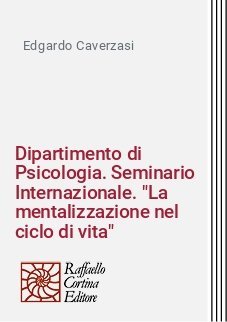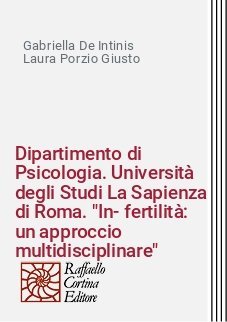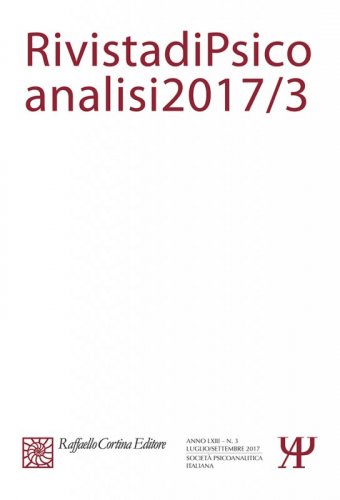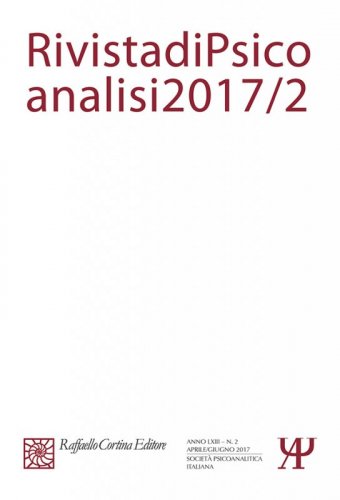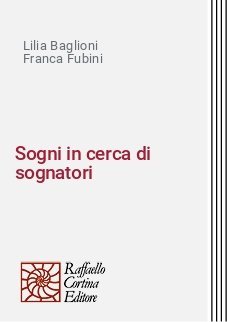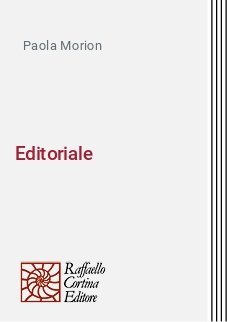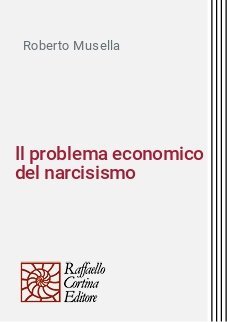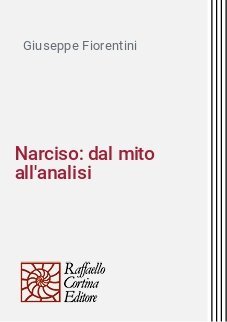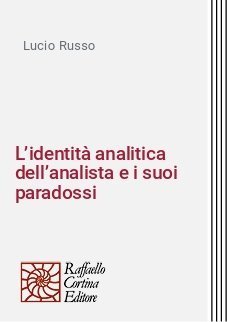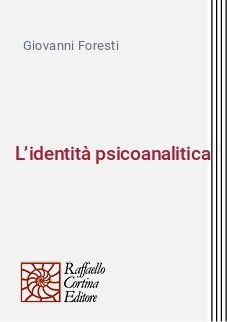Raffaello Cortina Editore
Sogni in cerca di sognatori
Ipotesi sulla storia e la teoria del Social Dreaming
rivista: La Rivista di Psicoanalisi
fascicolo: Rivista di Psicoanalisi 2017/2
Autori vari
Il Social Dreaming non è un’invenzione – secoli di condivisione dei sogni nella collettività lo testimoniano –, ma una scoperta che, insieme alle ricerche sulle dinamiche gruppali, portò Gordon Lawrence a ipotizzare che i sogni esplorati nel contesto dei molti, diverso da quello della diade psicoanalitica, avrebbero potuto rivelare significati sconosciuti e facilitare lo sviluppo del pensiero applicato a tematiche sociali, culturali, istituzionali. Lawrence propose una metodologia per sostenere tale processo. Il SD si focalizza sul sogno e non sul sognatore, ovvero sul sapere culturale dell’ambiente piuttosto che sul carattere individuale del sognatore. Fa sua la prospettiva della Sfinge – legata a problemi di conoscenza e di metodo scientifico – piuttosto che la prospettiva di Edipo – relata alla diade (Bion 1961). Il SD avviene nella «matrice», contenitore che cattura gli echi dei pensieri che si trovano nello spazio dei -molti-nella-mente, dove ciascuno di noi è connesso con l’ambiente sociale, culturale, naturale.
Parole chiave: Applicazioni, creatività, frattali, matrice, dove qualcosa può crescere; pensiero sistemico, universo/multiverso.
Dreams in Search of a Dreamer: A Hypothesis on the History and Theory of Social Dreaming. Social Dreaming is not an invention – centuries of collectively sharing dreams attest to this – but a discovery that, together with research on group dynamics, brought Gordon Lawrence to hypothesize that dreams explored in the context of many, differently than in the psychoanalytic dyad, would be able to reveal unknown meanings and to facilitate the development of thought applied to social, cultural, and institutional themes. Lawrence proposed a methodology for supporting such a process. Social Dreaming is focused on the dream and not on the dreamer, or rather on the cultural knowledge of the environment instead of on the individual character of the dreamer. His perspective was of the Sphinx – linked to problems of knowledge and the scientific method – rather than of Oedipus – related to the dyad (Bion 1961). Social Dreaming occurs in the «womb», the container that characterizes the echoes of thought in the space of the many-in-the-mind, where each of us is connected with the social, cultural, and natural environment.
Keywords: Applications, creativity, fractals, systematic thought, universal/multiversa, where something can grow, womb.
Rêves en quête de rêveurs: hypothèses sur l’histoire et la théorie de Social Dreaming. The Social Dreaming n’est pas une invention – de siècles de rêves communs chez la communauté le témoignage – mais une découverte qui, avec les recherche sur les dynamique groupales, mena Lawrence Gordon à hypotiser que l’exploration des rêves dans un cadre élargi, différent de celui de dyade psychanalytiques, pourrait révéler des significations inconnues et faciliter le développement d’une pensée appliquée à des thèmes sociaux, culturels, institutionnelles. Lawrence proposa une méthodologie pour soutenir ce processus. Le SD se concentre sur le rêve, non pas sur le rêveur, c’est-à-dire sur la connaissance culturelle de l’environnement plutôt que sur le caractère individuel du rêveur. Il fait sienne la perspective de la Sphinx – liée à des problèmes de connaissance et de méthode scientifique – plutôt que la perspective d’Œdipe – liée à la dyade (Bion, 1961). Le SD a lieu dans la «matrice», conteneur qui attire les échos des pensées qui se trouvent dans l’espace des plusieurs-dans-l’esprit, où chacun de nous est relié à l’environnement naturel social, culturel.
Mots-clés: Applications, créativité, fractales, matrice où quelque chose peut se développer; pensée systémique, univers / multivers.
Isueños en busca de soñadores: hipótesis sobre la historia y la teoría del Social Dreaming. El Social Dreaming no es una invención – siglos de compartir sueños en la colectividad lo atestiguan –, sino un descubrimiento que, junto a las investigaciones sobre las dinámicas de grupo, llevó a Gordon Lawrence a hipotizar que los sueños explorados en el contexto de la mayoría, distinto al del duo psicoanalítico, podrían revelar significados desconocidos y facilitar el desarrollo del pensamiento aplicado a temáticas sociales, culturales, institucionales. Lawrence propuso una metodología para sostener dicho proceso. El SD se focaliza en el sueño y non en el soñador, es decir en el saber cultural del ambiente más que en el carácter individual del soñador. Asume la perspectiva de la Esfinge –ligada a problemas de conocimiento y de método científico –, más que la perspectiva de Edipo – relacionada con el dúo (Bion 1961). El SD tiene lugar en la «matriz», contenedor que captura los ecos de los pensamientos que se encuentran en el espacio de la mayoría en la mente, donde cada uno de nosotros está vinculado con el ambiente social, cultural, natural.
Palabras clave: Aplicaciones, creatividad, donde algo puede crecer, fractal, matriz, pensamiento sistémico, universo/multiverso.
Träume auf der Suche nach Träumern: Hypothesen über die Geschichte und die Theorie vom Social Dreaming. Das Social Dreaming ist keine Erfindung – seit Jahrhunderten werden Träume in der Gruppe geteilt – sondern eine Entdeckung, die zusammen mit den Forschungen über Gruppendynamik Gordon Lawrence dazu veranlasst haben zu vermuten, dass die Träume, die in einer Gruppe exploriert werden – anders als in einer psychoanalytischen Dyade- unbekannte Bedeutungen entfalten und das Denken in Hinblick auf soziale, kulturelle, institutionelle Themen erleichtern. Lawrence schlug eine Methode vor, um diesem Prozess zu unterstützen. Das SD fokussiert auf den Traum, nicht auf den Träumer. Er machte sich dafür die Perspektive der Sphinx – im Zusammenhang mit den Fragen über Erkenntnis und wissenschaftliche Methode – und nicht die Perspektive des Ödipus – mit der Dyade verbunden (Bion 1961) – zu eigen. Das SD findet in der «Matrix» statt, ein Behälter für das Echo der Gedanken im Raum der Viele-im Geist-in dem jeder von uns mit der sozialen, kulturellen und natürlichen Umwelt verbunden ist.
Schlüsselwörter: Anwendungen, Kreativität, Matrix, systematisches Gedankengut, Universum/Multiversum, wo etwas wachsen kann.
Editoriale
rivista: La Rivista di Psicoanalisi
fascicolo: Rivista di Psicoanalisi 2017/2
di Paola Morion
Il problema economico del narcisismo
rivista: La Rivista di Psicoanalisi
fascicolo: Rivista di Psicoanalisi 2017/2
di Roberto Musella
L’autore, parafrasando il titolo del saggio di Freud Il problema economico del masochismo, ha voluto occuparsi del narcisismo alla luce dell’ultima teoria pulsionale freudiana. Nel saggio, con il contributo di un caso clinico, si mettono a confronto, dal punto di vista economico, due diverse e spesso contrapposte accezioni di narcisismo: da una parte il narcisismo inteso come ideale condizione primitiva anogettuale, priva di stimoli perturbanti, e dall’altra il narcisismo inteso come investimento libidico dell’Io. Alla luce delle considerazioni fatte sui destini del narcisismo viene affrontata la relazione del narcisismo con il sessuale discutendo la sequenza non sempre lineare tra autoerotismo, narcisismo e amore oggettuale. Infine, sempre in una prospettiva economica, si prende in considerazione la relazione tra narcisismo, masochismo e sadismo.
Parole chiave: Autoerotismo, Ideale dell’Io, Io, masochismo, narcisismo, sadismo, sessualità.
The Economic Problem of Narcissism. The author, in taking up the title of Freud’s essay The Economic Problem of Masochism, deals with narcissism in the light of the last Freudian instinctual theory. From an economic point of view, drawing on a clinical case, he compares two different and often conflicting meanings of narcissism: narcissism as a primitive, ideal, non-objectival condition, without disturbing stimuli, and narcissism as libidinal cathexis of the ego. Considering different outcomes of narcissism, he tackles the relationship between narcissism and sexuality. He discusses the sequence, which is not always clear, between auto-erotism, narcissism, and object love. Finally, again according to an economic perspective, he considers the relationship between narcissism, masochism, and sadism.
Keywords: Auto-erotism, Ego, Ego ideal, masochism, narcissism, sadism, sexuality.
Le problème économique du narcissisme. L’auteur, en paraphrasant le titre de l’essai de Freud Le problème économique du masochisme, a voulu s’occuper du narcissisme à la lumière de la dernière théorie pulsionnelle freudienne. Dans l’essai, avec la contribution d’un cas clinique, sont comparés, d’un point de vue économique, deux significations du narcissisme différentes et souvent opposées: d’un côté, le narcissisme compris comme idéale condition primitive anobjectuelle, privée de stimulations troublantes, de l’autre, le narcissisme entendu comme investissement libidinal du Moi. A la lumière des considérations faites sur les destinations du narcissisme, on traite la relation du narcissisme avec le sexuel, en discutant de la séquence, pas toujours linéaire, entre auto-érotisme, narcissisme et amour objectuel. Enfin, également du point de vue économique, on considère la relation entre narcissisme, masochisme et sadisme.
Mots-clés: Auto-érotisme, Idéal du Moi, Moi, masochisme, narcissisme, sadisme, sexualité.
El problema económico del narcisismo. El Autor, parafraseando el título del ensayo de Freud «El problema económico del masoquismo» ha querido ocuparse del narcisismo, teniendo en cuenta la última teoría pulsional de Freud. En este ensayo, con la ilustración de un caso clínico, se comparan desde el punto de vista económico, dos distintas acepciones del narcisismo que suelen contraponerse: por un lado el narcisismo esta concebido como una condición ideal primitiva a-objetual, libre de estímulos perturbadores, y por otro lado el narcisismo esta concebido como carga libídica del Yo. A la luz de lo expuesto sobre el destino del narcisismo, se aborda la relación entre el narcisismo y lo sexual, y se examina la secuencia no siempre lineal entre el autoerotismo, el narcisismo y el amor objetual. Por último se considera, siempre desde la perspectiva económica, la relación entre narcisismo, masoquismo y sadismo.
Palabras clave: Autoerotismo, Ideal del Yo, Yo, masoquismo, narcisismo, sadismo, sexualidad.
Das ökonomische Problem des Narzissmus. Der Autor hat sich, in Anspielung auf das Essay von Freud Die ökonomische Problematik des Masochismus mit dem Narzissmus aus der Perspektive der letzten freudschen Triebtheorie beschäftigen wollen. In dem Aufsatz, der den Beitrag eines klinischen Falls enthält, vergleicht er, von einem ökonomischen Standpunkt aus zwei unterschiedliche und oft gegensätzliche Bedeutungen von Narzissmus: Auf der einen Seite wird der Narzissmus als objektloser idealer Urzustand verstanden, ohne unheimliche Reize, und auf der anderen Seite wird der Narzissmus als libidinöse Besetzung des Ichs verstanden. Im Lichte der Überlegungen über das Schicksal des Narzissmus wird sich mit der Beziehung des Narzissmus zum Sexuellen auseinandergesetzt und man diskutiert über die nicht immer eindeutige Reihenfolge von Autoerotismus, Narzissmus und Objektliebe. Schließlich, immer aus einer ökonomischen Sicht heraus, betrachtet man die Beziehung zwischen Narzissmus, Masochismus und Sadismus.
Schlüsselwörter : Autoerotismus, Ich, Ichideal, Masochismus, Narzissmus, Sadismus, Sexualität.
Narciso: dal mito all'analisi
rivista: La Rivista di Psicoanalisi
fascicolo: Rivista di Psicoanalisi 2017/2
di Giuseppe Fiorentini
Assumendo il mito come una narrazione che trova la propria eco nelle strutture patologiche individuali e che può aiutarci a comprenderle, l’Autore si avvale della storia di Narciso per discutere del narcisismo patologico e considerare le difficoltà che incontriamo nel trattare analiticamente persone con tali problematiche. Viene riportato del materiale di un’analisi di un paziente con estesi tratti narcisistici ed angosciato dall’idea dell’invecchiamento e della morte. Successivamente vengono trattate alcune tematiche di carattere clinico teorico sul narcisismo, incluso quello dell’analista. Sono inoltre esplorate alcune prospettive che possano aiutarci a riflettere sugli impasse o i rischi d’interminabilità non infrequenti in questi casi. È infine discusso il ruolo svolto dall’analista nella cura, cui sarebbe richiesto, secondo l’Autore, un processo di compartecipazione trasformativa.
Parole Chiave: Analisi interminabile, immortalità, invecchiamento, limiti, mito, morte, narcisismo dell’analista, Narciso, perfezione, trasformazioni.
Narcissus: From Mith To Analysis. Referring to myth as a tale that echoes individual pathological structures and can help us understand them, the author utilizes the story of Narcissus to discuss pathological narcissism and to consider the difficulties encountered in treating patients affected by such problems. Clinical material is presented from the analysis of a patient with extensive narcissistic traits and anxieties about ageing and death. Clinical and theoretical issues related to narcissism are discussed subsequently, including the analyst’s narcissism. In conclusion, the author deals with the analyst’s role in the cure and stresses the importance, in his view, of the shared transformations that analyst and patient should undergo.
Keywords: Ageing, analyst’s narcissismus, death, immortality, interminable analysis, limits, myth, Narcissus, perfection, transformations.
Narcisse: du mythe à l’analyse. En assumant que le mythe soit un récit qui trouve son écho dans les structures pathologiques individuelles, et qui peut nous aider à les comprendre, l’auteur utilise l’histoire de Narcisse pour discuter du narcissisme pathologique et examiner les difficultés que nous rencontrons dans le traitement analytique des personnes avec de tels problèmes. On rapporte du matériel d’une analyse d’un patient avec des traits narcissiques prolongés et bouleversé par l’idée du vieillissement et de la mort. Ensuite, on discute des questions théoriques et cliniques sur le narcissisme, y comprises celles de l’analyste. D’autres perspectives sont également explorées qui peuvent nous aider à réfléchir sur l’impasse ou les risques d’interminabilité pas du tout rares dans ces cas. Enfin, l’Auteur discute du rôle joué par l’analyste dans le traitement, auquel il faudrait demander un processus de participation transformative.
Mots-clés: Interminable, immortalité, vieillissement, limites, mythe, mort, narcissisme de l’analyste, Narcisse, perfection, transformations.
Narciso: del mito al análisis. Se asume el mito como una narración que encuentra su propia eco en las estructuras patológicas individuales y que nos ayuda a comprenderlas. El Autor utiliza la historia de Narciso para debatir sobre el narcisismo patológico y examinar las dificultades que nos encontramos cuando tratamos analíticamente a personas con dichas problemáticas. Se describe el material de análisis de un paciente con amplios rasgos nacisistas y angustiado por la idea de envejecer y por la muerte. A continuación se examinan algunos asuntos clinicos-teóricos sobre el narcisismo, incluido el del analista. Se exploran además algunas perspectivas que pueden ayudarnos a reflexionar sobre el empasse o los riesgos frecuentes de casos interminables. Por ultimo, se discute entorno al papel del analista en el tratamiento, a quien se le exige, según el Autor, un proceso de coparticipación trasformadora.
Palabras clave: Análisis interminable, envejecimiento, inmortalidad, limites, mito, muerte, narcisismo del analista, Narciso, perfección, transformaciones.
Narziss: Vom Mythos bis zur Analyse. Der Mythos wird als eine Narration angenommen, die das eigene Echo in den individuellen pathologischen Strukturen findet und die uns helfen kann, sie zu verstehen. Der Autor verwendet die Geschichte von Narziss, um über den pathologischen Narzissmus zu diskutieren und die Schwierigkeiten zu betrachten, denen wir begegnen, wenn wir Menschen mit solch einer Problematik analytisch behandeln. Es wird Fallmaterial der Analyse eines Patienten mit umfangreichen narzisstischen Zügen dargestellt, der von der Idee des Alterns und des Todes gequält wird. Nachfolgend werden einige theoretisch-klinische, charakteristische Themen über den Narzissmus behandelt, einschließlich des Analytikers selbst. Es werden ferner auch einige Perspektiven erkundet, die uns helfen können, über die mögliche Sackgasse oder die Unendlichkeitsrisiken nachzudenken, die in diesen Fällen nicht selten sind. Schließlich wird die Rolle des Analytikers in der Behandlung erörtert, die, so der Autor, einen Prozess der transformativen Mitbeteiligung erforderlich macht.
Schlüsselwörter : Altern, Grenzen, Mythen, Narziss, Narzissmus des Analytikers, Perfektion, Tod, Transformation, Unendliche Analyse, Unsterblichkeit.
L’identità analitica dell’analista e i suoi paradossi
rivista: La Rivista di Psicoanalisi
fascicolo: Rivista di Psicoanalisi 2017/2
di Lucio Russo
L’autore affronta il tema dell’identità analitica dell’analista e lo esplora attraverso alcuni paradossi per mettere in evidenza che il lavoro analitico, che costituisce l’identità analitica, si fonda sulla rottura del senso comune e della logica, per rimanere nell’ordine del fantasma. Si affronta il tema identitario a partire dalla convinzione che essere sempre psicoanalista è una illusione. Illusione necessaria accompagnata da costante disillusione. Citando, accanto a Freud, Binswanger, Fedida, De M’Uzan, Green si esplora l’area del transfert-controtransfert e del negativo come ambiti specifici. I fondamenti della psicoanalisi si trovano nello scarto tra i termini del linguaggio classico della scienza del ‘900 e l’innovazione della parola psicoanalitica, pertanto l’identità analitica dello psicoanalista non è stabile né permanente, nel testo viene descritta con la metafora del saltatore. Il salto può essere affrontato con un dispositivo che si costruisce come intreccio tra relazione analitica e autoanalisi dell’analista, lavoro che apre a processi interminabili di nuove forme di identità.
Parole chiave: Identità analitica, estraneo - familiare, illusione, negativo, persona dell’analista, scissione.
The Analyst’s Analytic Identity and Its Paradoxes. The author addresses the topic of the analyst’s analytic identity and explores it through some paradoxes to highlight that analytic work, which constitutes the analytic identity, is based on a rupture of common sense and logic, in order to dwell in the realm of the fantastic. The theme of identity is addressed starting from the conviction that always being a psychoanalyst is an illusion – a necessary illusion accompanied by constant disillusionment. Citing, along with Freud, Binswanger, Fedida, de M’Uzan, and Green, the transference-countertransference and the area of the negative are explored as specific dimensions. The foundations of psychoanalysis can be located in the disparity between the classical scientific language of the twentieth century and the innovation of the psychoanalytic word; therefore, the psychoanalyst’s analytic identity is not stable or permanent, and in this paper, it is described with the metaphor of a jumping person. The jump can be approached within a framework that is constructed as an interweaving between the analytic relationship and the analyst’s self-analysis – a task that opens up endless processes of new forms of identity.
Keywords: Analytic identity, extraneous-familiar, illusion, negative, person of the analyst, split.
L’identité analytique de l’analyste et ses paradoxes. L’auteur aborde la question de l’identité analytique de l’analyste et la explore à travers des paradoxes pour mettre en évidence que le travail analytique, qui constitue l’identité analytique, est fondé sur la rupture du sens commun et de la logique, pour rester dans l’ordre du fantasme. Il aborde la question de l’identité à partir de la conviction qu’être tout le temps un analyste est une illusion. Illusion nécessaire, accompagnée d’une constante désillusion. En citant Freud, Binswanger, Fedida, De M’Uzan, Green, on explore le champ du transfert-contretransfert et du négatif en tant que domaines spécifiques. Les fondements de la psychanalyse se trouvent dans l’écart entre les termes de la langue classique de la science du ‘900 et l’innovation de la parole psychanalytique. Donc, l’identité analytique du psychanalyste n’est pas stable ou permanente. Dans le texte elle est décrite avec la métaphore du sauteur. Le saut peut être abordé à travers un dispositif qui est construit comme entrecroisement de relation analytique et de auto-analyse de l’analyste. Ce travail favorise des processus interminables de nouvelles formes d’identité.
Mots-clés: Identité analytique, étrange-familier, illusion, négatif, personne de l’analyste, clivage.
La identidad analítica del analista y sus paradojas. El autor enfrenta el tema de la identidad analítica del analista y lo explora a través de algunas paradojas para subrayar que el trabaja analítico, que constituye la identidad analítica, se funda en la ruptura del sentido común y de la lógica, para permanecer en el orden del fantasma. Se aborda el tema identitario a partir de la convicción de que ser siempre psicoanalista es una ilusión. Ilusión necesaria acompañada por una constante desilución. Junto a Freud, cita a Binswanger, Fedida, De M’Uzan y Green para explorar el área del transfert-controtransfert y de lo negativo como ámbitos específicos. Los fundamentos del psicoanálisis se encuentran en la brecha entre los términos del lenguaje clásico de la ciencia del siglo XX y la innovación de la palabra psicoanalítica; por lo tanto, la identidad analítica del psicoanalista no es ni estable ni permanente: en el texto se describe con la metáfora del saltador. El salto puede enfrentarse con un dispositivo que se construye como trama entre relación analítica y autoanálisis del analista, trabajo que abre a procesos interminables de nuevas formas de identidad.
Palabras clave: Extraño-familiar, escisión, identidad analítica, ilusión, negativo, persona del analista.
Die Analytische Identität des Analytikers und Ihre Paradoxien. Der Autor befasst sich mit dem Thema der analytischen Identität des Analytikers und untersucht sie durch einige Paradoxien, um aufzuzeigen, dass die analytische Arbeit, die die analytische Identität bildet, auf dem Abbau des gesunden Menschenverstandes und der Logik gegründet ist, um in der phantasmatischen Ordnung zu bleiben. Man befasst sich mit der Frage der Identität auf der Grundlage der Überzeugung, dass die Vorstellung, immer Psychoanalytiker zu sein, eine Illusion ist. Solch eine Illusion ist notwendig und wird von ständiger Enttäuschung begleitet. Neben Freud werden Binswanger, Fedida, De M’Uzan, Green erwähnt und es wird der Bereich der Übertragung-Gegenübertragung und des Negativen als spezifischer Bereich erforscht. Die Grundlagen der Psychoanalyse sind im Zwischenraum zwischen den Begriffen der klassischen Sprache der Wissenschaft des 19.jahrhunderts einerseits und der Innovation des psychoanalytischen Wortes andererseits zu finden, so dass die analytische Identität des Psychoanalytikers nicht stabil oder dauerhaft ist. Sie wird in dem Text mit der Metapher des Jumpers dargestellt. Der Bogen kann sich als Verschränkung zwischen analytischer Beziehung und Selbstanalyse des Analytikers aufspannen, und das ist eine Arbeit, die einen endlosen Prozess neuer Identitätsformen eröffnet.
Schlüsselwörter: Analytische Identität, Fremd - Familie, Illusion, Negatives, Person des Analytikers, Spaltung.
L’identità psicoanalitica
Cinque ipotesi per un dibattito
rivista: La Rivista di Psicoanalisi
fascicolo: Rivista di Psicoanalisi 2017/2
di Giovanni Foresti
In questo lavoro l’identità psicoanalitica viene discussa ricorrendo a cinque ipotesi. La prima è che l’identità sia una funzione logica e biologica che dipende dai sistemi di differenze che la definiscono. La seconda è che si costituisca come un paradosso permanente: un paradosso, cioè, che non può venir mai definitivamente risolto. La terza è che la logica del paradosso tende a essere negata, anche se è ben presente nei testi fondanti della psicoanalisi. La quarta è che l’identità psicoanalitica non è solo il prodotto del training, ma dev’essere intesa anche come l’obiettivo della formazione permanente dello psicoanalista. La quinta è che il funzionamento delle istituzioni psicoanalitiche dovrebbe mirare a facilitare la necessaria apertura identitaria, mentre numerosi fenomeni gruppali e individuali tendono a ostacolare il lavoro psicosociale che sarebbe necessario.
Parole chiave: Identità, paradosso, training psicoanalitico, visione binoculare.
Psychoanalytic Identity: Five Hypotheses for Consideration. In this paper, psychoanalytic identity is discussed in reference to five hypotheses. The first is that identity may be a logical and biological function that depends on the systems of difference that define it. The second is that it may be constituted as a permanent paradox: a paradox, that is, that can never be definitively resolved. The third is that the logic of the paradox tends to be denied, even though it is very much present in the foundational texts of psychoanalysis. The fourth is that psychoanalytic identity is not only the product of formal training, but must also be understood as the objective of the psychoanalyst’s ongoing development. The fifth is that the operative work of psychoanalytic institutions should aim at facilitating the necessary openness to identity formation, while numerous group and individual phenomena tend to hinder the psychosocial work that would be necessary.
Keywords: Binocular vision, identity, paradox,psychoanalytic training.
L’identité psychanalytique: cinq hypothèses de débat. Dans ce travail, l’identité psychanalytique est discutée en recourant à cinq hypothèses. La première est que l’identité est une fonction logique et biologique qui dépend des systèmes de différences qui la définissent. La seconde est qu’elle se constitue comme un paradoxe permanent: un paradoxe, à savoir, qui ne peut jamais être définitivement résolu. La troisième est que la logique du paradoxe tend à être niée, même si elle est clairement présente dans les textes fondateurs de la psychanalyse. La quatrième est que l’identité psychanalytique est non seulement le produit du training, mais elle doit être comprise comme l’objectif de la formation continue du psychanalyste. La cinquième est que le fonctionnement des institutions psychanalytiques devrait viser à faciliter la nécessaire ouverture identitaire, tandis que de nombreux phénomènes groupales et individuels ont la tendance à entraver le travail psychosocial qui serait nécessaire.
Mots-clés: Identité, paradoxe, training psychanalytique, vision binoculaire.
La identidad psicoanalítica y sus paradojas: cinco hipótesis para un debate. En este trabajo se discute en torno a la identidad psicoanalítica a partir de cinco hipótesis. La primera es que la identidad es una función lógica y biológica que depende de los sistemas de diferencias que la definen. La segunda es que se constituye como una paradoja permanente: una paradoja, es decir, que nunca puede resolverse definitivamente. La tercera es que la lógica de la paradoja tiende a ser negada, aunque está presente en los textos fundadores del psicoanálisis. La cuarta es que la identidad psicoanalítica no es solo el producto del entrenamiento, sino que tiene que entenderse también como el objetivo de la formación permanente del psicoanalista. La quinta es que el funcionamiento de las instituciones psicoanalíticas debería apuntar a facilitar la necesaria apertura identitaria, mientras numerosos fenómenas grupales e individuales tienden a obstaculizar el trabajo psicosocial que sería necesario.
Palabras clave: Entrenamiento psicoanalítico, identidad, paradoja, visión binocular.
Die psychoanalytische Identität: Fünf Hypothesen zur Debatte. In dieser Arbeit wird anhand von fünf Hypothesen die psychoanalytische Identität erörtert. Die erste ist, dass die Identität eine logische und biologische Funktion ist, die von den Unterschieden der Systeme, die sie definieren, abhängig ist. Die zweite ist, dass sie sie als dauerhafte Paradoxie bildet: D. h. eine Paradoxie, die nie endgültig gelöst werden kann. Die dritte ist, dass die Logik der Paradoxie zur Leugnung zu neigen scheint, obwohl sie eindeutig in den Gründungstexten der Psychoanalyse vorhanden ist. Die vierte ist, dass die psychoanalytische Identität nicht nur das Produkt der psychoanalytischen Ausbildung ist, sondern sie soll auch als Ziel der fortdauernden Weiterbildung des Psychoanalytikers verstanden werden. Die fünfte ist, dass die Arbeitsweise der psychoanalytischen Institutionen das Ziel haben sollte, die notwendige Identitätsöffnung zu erleichtern, während zahlreiche Einzel - und Gruppenphänome dazu tendieren, die psychosoziale Arbeit zu verhindern, die notwendig wäre.
Schlüsselwörter : Binokularsehen, Identität, Paradoxie, psychoanalytische Ausbildung.
Identità dell’analista e mondo digitale
Una nuova frontiera della psicoanalisi
rivista: La Rivista di Psicoanalisi
fascicolo: Rivista di Psicoanalisi 2017/2
di Andrea Marzi
È innegabile che il mondo digitale stimoli approfondimenti sulla psicoanalisi stessa e sugli spazi virtuali della mente. Tutto questo riguarda il paziente che porta un bagaglio «informatico» nella seduta, ma anche l’analista, sottoposto a correnti che fortemente sollecitano le sue precedenti coordinate di riferimento, cimentandone l’identità. Cercare di comprendere meglio quest’ultima condizione richiede che ci si addentri prima nella definizione della identità dell’analista, poi nella natura della realtà virtuale, con le sue conseguenze nel campo psicoanalitico e sull’identità stessa dell’analista, cercando una possibile integrazione. Alcune illustrazioni cliniche si sforzano di approfondire il campo di riflessione su questo tema , non solo in linea generale, ma anche riguardo alla frontiera dell’analisi remota.
Parole Chiave: Analisi remota, cyberspace, clinica psicoanalitica, identità, identità dell’analista, informatica, psicoanalisi, realtà virtuale, teleanalisi.
The analyst’s identity and the digital world: a new frontier in psychoanalysis. it is undeniable that the digital world invites in-depth studies of psychoanalysis itself and of the virtual spaces of the mind. all this pertains to the patient who brings «computerized» baggage into the session, but also to the analyst, who is subjected to currents that intensely stimulate his preexisting frames of reference, reinforcing his identity. trying to better understand this latter condition requires first examining the definition of the analyst’s identity and then the nature of virtual reality, with its impact on the psychoanalytic field and on the analyst’s identity itself, seeking possible integration. some clinical illustrations are used in an attempt to deepen the field of reflection on this topic – not only in general, but also in regard to the frontier of distance analysis.
keywords: Analyst’s identity, cyberspace, clinical psychoanalysis, computerization, distance analysis, identity, psychoanalysis, tele-analysis, virtual reality.
Identité de l’analyste et monde numérique: une nouvelle frontière de la psychanalyse. Il est indéniable que le monde numérique stimule des approfondissements sur la psychanalyse elle-même, et sur les espaces virtuels de l’esprit. Tout cela concerne le patient qui apporte un bagage «informatique» dans la séance, mais l’analyste aussi, pressé par des courants qui sollicitent fortement ses précédentes coordonnées de référence, en en stressant l’identité. Essayer de mieux comprendre cette dernière condition exige que nous examinons préalablement la définition de l’identité de l’analyste, et ensuite la nature de la réalité virtuelle, avec ses conséquences dans le champ psychanalytique et sur l’identité même de l’analyste, en cherchant une possible intégration. Certaines illustrations cliniques visent à approfondir le champ de réflexion sur cette question, non seulement en général, mais aussi par rapport à la frontière de l’analyse à distance.
Mots-clés: Analyse à distance, cyberespace, clinique psychanalytique, identité, identité de l’analyste, informatique, psychanalyse, réalité virtuelle, télé-analyse.
Identidad del analista y mundo digital: una nueva frontera del psicoanálisis. Es innegable que el mundo digital estimula la profundización sobre el psicoanálisis mismo y sobre los espacios virtuales de la mente. Todo esto tiene que ver con el paciente que lleva un bagaje «informático» a la sesión, pero también con el analista, sujeto a corrientes que solicitan con fuerza sus precedentes puntos de referencia, poniendo a prueba la identidad. Tratar de comprender mejor esta última condición exige que entremos primero en la definición de identidad del analista, luego en la naturaleza de la realidad virutual con sus consecuencias en el campo psicoanalítico y en la identidad misma del analista, buscando una posible integración. Algunas ilustraciones clínicas se esfuerzan en profundizar el campo de reflexión sobre este tema, no solo en línea general, sino también respecto a la frontera del análisis remoto.
Palabras Clave: Anàlisis a distancia, ciberespacio, clinica psicoanalítica, identidad, identidad del analista, informàtica, psicoanàlisis, realidad virtual, teleanàlisis.
Die Identität des Analytikers und die digitale Welt: Eine neue Grenze der Psychoanalyse. Es ist unbestreitbar, dass die digitale Welt Vertiefungen über die Psychoanalyse selbst und über die virtuellen Räume der Psyche anregt. Das betrifft nicht nur den Patienten, der eine Fülle an «Computerwissen» in die Sitzung bringt, sondern auch den Analytiker, der unter Strömungen steht, die stark in seine früheren Referenzkoordinaten eindringen und seine Identität auf die Probe stellen. Der Versuch, den letztgenannten Zustand besser zu verstehen, erfordert, dass wir zuerst die Definition der Identität des Analytikers anschauen, dann die Art der virtuellen Realität, mit ihren Folgen auf dem Gebiet der Psychoanalyse und auf die Identität des Analytikers selbst, um eine mögliche Integration zu versuchen. Am Beispiel einiger klinischer Fälle wird sich bemüht, den Reflexionsbereich dieses Themas zu vertiefen, nicht nur im Allgemeinen, sondern auch in Bezug auf die Grenze der Fernanalyse
Schlüsselwörter: Cyberspace, Computerwesen, Fernanalyse, Identität, Identität des Analytikers, Psychoanalyse, psychoanalytische Klinik, Tele-Analyse, Virtuelle Realität.
Che farò senza Euridice?
Orfeo ed Euridice, de’ Calzabigi-Gluck
rivista: La Rivista di Psicoanalisi
fascicolo: Rivista di Psicoanalisi 2017/2
di Anna Ferruta
Quello che interessa approfondire è l’identità analitica dell’analista, cioè la specificità del suo funzionamento mentale, concetto condiviso nei lavori di Foresti, Marzi, Russo. L’identità analitica comporta una capacità di esposizione all’alterità dell’«altro» senza perdere le sufficienti coordinate spaziotemporali. Quella analitica non è un’identità debole, anzi, da un punto di vista concettuale strutturale è forte, nel senso che ha una sua specificità concettuale e operativa ben definita. Ma è un’identità fragile, perché continuamente resa fragile da questo lavoro di esposizione all’alterità.
Parole chiave: Alterità, ascolto, identità analitica, oggetto non-me, setting.
What Will I Do without Eurydice? (Orpheus and Eurydice, an Opera by Gluck with Libretto by Calzabigi). Of interest to explore here is the analyst’s analytic identity – that is, the particular characteristics of his mental operations, a shared concept in the papers of Foresti, Marzi, and Russo. Analytic identity involves a capacity for exposition of the «other’s» alterity without losing the necessary spatiotemporal coordinates. The analytic identity is not a weak one, and indeed, from a conceptual and structural point of view, it is strong in the sense that it has a certain conceptual and operative specificity that is well defined. But it is a fragile identity because it is continually rendered so by the task of the exposition of alterity.
Keywords: Alterity, listening, analytic identity, not-me object, setting.
Que vais-je faire sans Euridice? (Orfeo ed Euridice, de’ Calzabigi – Gluck). Il est très important d’approfondir l’identité analytique de l’analyste, c’est-à-dire la spécificité de son fonctionnement mental: tout cela est partagé dans les travaux de Foresti, Marzi, Russo. L’identité analytique implique une capacité d’exposition à l’altérité de l’autre sans perdre les coordonnées espace-temporelles. Cette identité analytique n’est pas du tout faible; d’un point de vue conceptuel structurel, elle est forte, dans le sens qui a sa spécificité conceptuelle et opérationnelle bien définie. Mais cette identité est fragile, car elle est toujours fragilisée par ce travail d’exposition à l’altérité.
Mots-clés: Altérité, écoute, identité analytique, not-me, setting.
Qué haré sin Euridice? (Orfeo y Euridice, de’ Calzabigi - Gluck). Lo que interesa profundizar es la identidad analítica del analista, es decir, la especificidad de su funcionamiento mental, concepto compartido en los trabajos de Foresti, Marzi y Russo. La identidad analítica implica una capacidad de exposición a la alteridad del «otro» sin perder las suficientes coordinadas espacio-temporales. No se trata de una identidad débil, más aún, desde un punto de vista conceptual estructural es fuerte, en el sentido de que tiene una propia especificidad conceptual y operativa bien definida. Pero es una identidad frágil, porque está continuamente debilitada por este trabajo de exposición a la alteridad.
Palabras clave: Alteridad, escucha, identidad analítica, objeto no-yo, sesión psicoanalítica.
Was werde ich ohne Eurydike tun? (Orpheus und Eurydike, de ‚Calzabigi - Gluck). Was dem Autor interessiert, ist die analytische Identität des Analytikers, d.h. die Spezifität seiner psychischen Funktionen zu verstehen und zu vertiefen. Das ist das gemeinsame Konzept in den Arbeiten von Foresti, Marzi und Russo. Die analytische Identität beinhaltet eine Expositionsfähigkeit des Andersseins des «Anderen», ohne die Raum-Zeit-Koordinaten zu verlieren. Die analytische Identität ist nicht schwach, sondern sie ist in der Tat, von einer strukturellen konzeptionellen Sicht aus stark, so dass seine konzeptionelle und operative Spezifität gut definiert ist. Aber diese Identität ist auch zerbrechlich, weil sie immer wieder von der Arbeit der Exposition gegenüber der Andersartigkeit zerbrochen werden kann.
Schlüsselwörter: Analytische Identität, Anderssein, Hören, Objekt nicht-Ich.
 ita
ita
 Eng
Eng


